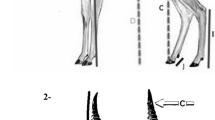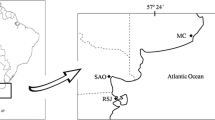Summary
The moults and weights in captivity of sixCarduelis flammea cabaret and twoC. f. flammea are described. The birds started to moult on dates between 10 and 31 July, took 46–69 days to moult completely, and 44–58 days to replace their primaries. On average, the secondaries and the inner three primaries ofcabaret each took 14 days to grow, and the outer primaries took progressively longer, the outermost taking 21 days. Growth rates varied for different feathers. Within each race equivalent feathers in different birds took approximately the same time to grow, but those of the largerC. f. flammea took slightly longer, on average, than those ofcabaret. In both races, primaries 4–7 were shed at longer intervals than the rest, and the last three secondaries at shorter intervals than the first three.
All the tail feathers are shed over 7–11 days, and incabaret the outer one took 20 days to grow at 2.4 mm per day. Inflammea it is longer and took 21 days to grow at 2.7 mm per day. The number of body feathers dropped varied greatly from day to day, but birds that shed their primaries at comparatively long intervals also dropped their body feathers more slowly.
On all aspects on which comparative data are available, the moults of these captive Redpolls are closely similar to those of the wild birds studied byEvans (1966, 1969) andEvans et al. (1967).
In contrast, the weights and fat contents of captive birds were much higher than those of free-living Redpolls, both before and after moult, but were similar during moult. Two captive birds killed for analysis a month after moult, contained much more fat (4.6 gm. and 2.0 gm.) than has been recorded from wild Redpolls (maximum 1.9 gm.). It is suggested that the reduction of fat during the moult of captive birds is the result of a distinct physiological condition prevailing at this time that prevented excessive fat-storage. However, fat deposition in captive birds in the autumn (presumably equivalent to premigratory fattening in wild birds) began a few days before the end of moult (whenever this occurred) and took 5–10 days to complete.
Zusammenfassung
Die Mauser und das Gewicht von 6Carduelis flammea cabaret und 2C. f. flammea, alle in Gefangenschaft, wurden untersucht. Die Vögel begannen die Mauser an Daten, die zwischen 10. und 31. Juli lagen. Sie währte 46–69 Tage, davon entfielen 44–58 Tage auf den Ersatz der Handschwingen. Im Durchschnitt wuchsen die Armschwingen und die drei innersten Handschwingen voncabaret je 14 Tage lang, die äußeren Handschwingen zunehmend länger, die äußersten 21 Tage lang. Die Wachstumsgeschwindigkeit war nicht bei allen Federn gleich. Homologe Federn verschiedener Vögel der gleichen Subspezies wuchsen ungefähr gleich lange; bei der größeren Subspeziesflammea verhornten sie etwas später als beicabaret. Bei beiden Rassen fielen die Handschwingen 4 bis 7 in größeren Abständen aus als die übrigen, und die drei äußersten in kürzeren Abständen als die drei innersten.
Alle Stuerfedern fielen binnen 7–11 Tagen aus. Beicabaret wuchs die äußerste (S 6) 20 Tage lang, und zwar täglich 2,4 mm. Die Zahl ausgefallener Körperfedern variierte beträchtlich von Tag zu Tag, aber so lange die Vögel ihre Handschwingen mit relativ langen Abständen wechselten, erneuerten sie gleichzeitig auch das Körpergefieder langsamer.
In den schon vergleichbaren Einzelheiten stimmt die Mauser dieser gekäfigten Birkenzeisige in jeder Hinsicht gut überein mit der Mauser von freilebenden, die vonEvans (1966, 1969) und vonEvans et al. (1967) untersucht worden ist.
Das Gewicht und der Fettgehalt der Gekäfigten waren sowohl vor als auch nach der Mauser viel höher als bei Freilebenden; sie glichen einander aber während der Mauser. Zwei Gekäfigte, die einen Monat nach der Mauser für die Analyse getötet wurden, enthielten viel mehr Fett (4,6 g und 2,0 g) als bei freilebenden Birkenzeisigen gefunden worden ist (bei diesen maximal 1,9 g). Es wird vermutet, daß die während der Mauser der Gekäfigten festgestellte Verminderung des Fettgehaltes bewirkt wird durch einen besonderen physiologischen Prozeß, der zu dieser Zeit eine übermäßige Fettspeicherung verhindert. Aber einige Tage vor dem Ende der Mauser begann bei den Gekäfigten die Fettablagerung; sie war nach 5 bis 10 Tagen beendet. Das entspricht wahrscheinlich der prae-migratorischen Fettspeicherung bei Freilebenden.
Similar content being viewed by others
Literature
Berger, W. (1967): Die Mauser des Sprossers (Luscinia luscinia L.) J. Orn. 108, p. 320–327.
Dwight, J. (1900): The sequence of plumages and moults of the passerine birds of New York. Ann. New York Acad. Sci. 13: 73–360.
Evans, P. R. (1966): Autumn movements, moult and measurements of the Lesser RedpollCarduelis flammea cabaret. Ibis 108, p. 183–216.
- (1969): Migration and pre-migratory fat deposition in the Lesser RedpollCarduelis flammea cabaret. Condor.
—, andSinclair, G. R. (1967): Moult and weight changes of Redpolls,Carduelis flammea, in north Norway. Ornis Fennica 44, p. 33–41.
King, J. R., andFarner, D. S. (1959): Premigratory changes in body weight and fat in wild and captive male White-crowned Sparrows. Condor 61, p. 315–324.
Newton, I. (1967): Feather growth and moult in some captive finches. Bird Study 14, p. 10–24.
— (1968): The moulting seasons of some finches and buntings. Bird study 15, p. 84–92.
— (1968a): The temperatures, weights and body composition of molting Bullfinches. Condor 70, p. 323–332.
Stresemann, E., andStresemann, V. (1966): Die Mauser der Vögel. J. Orn. 107, Suppl.
Zeidler, K. (1966): Untersuchungen über Flügelbefiederung und Mauser des Haussperlings(Passer domesticus L.) J. Orn. 107, p. 113–153.
Author information
Authors and Affiliations
Rights and permissions
About this article
Cite this article
Newton, I. Moults and weights of captive RedpollsCarduelis flammea . J Ornithol 110, 53–61 (1969). https://doi.org/10.1007/BF01671137
Published:
Issue Date:
DOI: https://doi.org/10.1007/BF01671137




